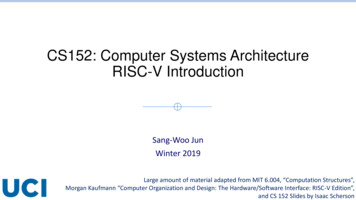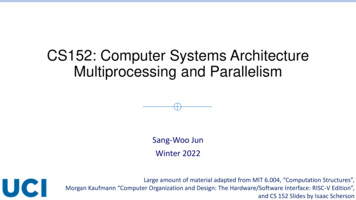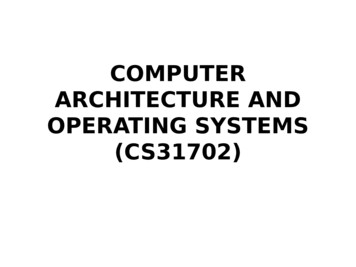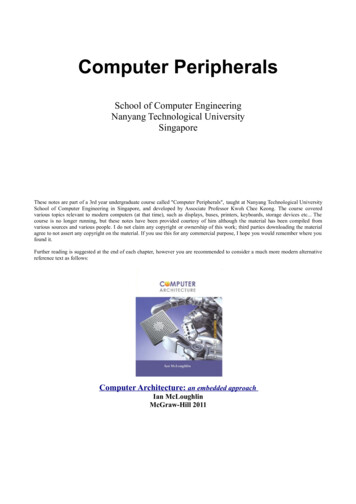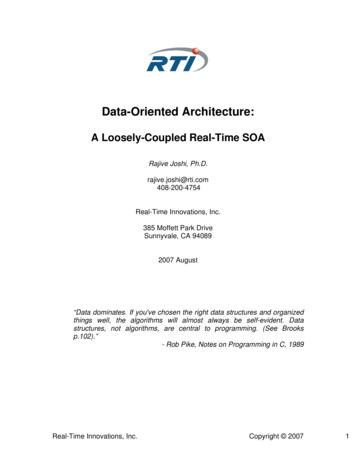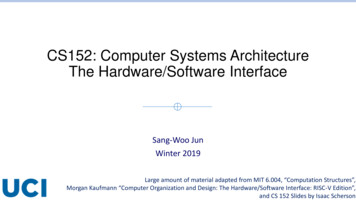
Transcription
CS152: Computer Systems ArchitectureThe Hardware/Software InterfaceSang-Woo JunWinter 2019Large amount of material adapted from MIT 6.004, “Computation Structures”,Morgan Kaufmann “Computer Organization and Design: The Hardware/Software Interface: RISC-V Edition”,and CS 152 Slides by Isaac Scherson
Course outline Part 1: The Hardware-Software Interfaceo What makes a ‘good’ processor?o Assembly programming and conventions Part 2: Recap of digital designo Combinational and sequential circuitso How their restrictions influence processor design Part 3: Computer Architectureo Computer Arithmetico Simple and pipelined processorso Caches and the memory hierarchy Part 4: Computer Systemso Operating systems, Virtual memory
Eight great ideas Design for Moore’s LawtodayUse abstraction to simplify designMake the common case fastPerformance via parallelismPerformance via pipeliningPerformance via predictionHierarchy of memoriesDependability via redundancy
Great idea:Use abstraction to simplify design Abstraction helps us deal with complexity by hiding lower-level detailo One of the most fundamental tools in computer science!o Examples: Application Programming Interface (API),System calls,Application Binary Interface (ABI),Instruction-Set Architecture
The Instruction Set Architecture An Instruction-Set Architecture (ISA) is the abstraction between thesoftware and processor hardwareo The ‘Hardware/Software Interface’o Different from ‘Microarchitecture’, which is how the ISA is implemented The ISA allows software to run on different machines of the samearchitectureo e.g., x86 across Intel, AMD, and various speed and power ratings
Below your program Application softwareo Written in high-level language System softwareo Compiler: translates HLL code to machine codeo Operating System: service code Handling input/output Managing memory and storage Scheduling tasks & sharing resources Hardwareo Processor, memory, I/O controllers
Levels of program code High-level languageo Level of abstraction closer to problem domaino Provides for productivity and portability Assembly languageo Textual representation of instructions Hardware representationo Binary digits (bits)o Encoded instructions and dataInstruction Set Architecture (ISA) isthe agreement on what this will do
A RISC-V Example This four-byte binary value will instruct a RISC-V CPU to performo add values in registers x19 x10, and store it in x18o regardless of processor speed, internal implementation, or chip designerSource: Yuanqing Cheng, “Great Ideas in Computer Architecture RISC-V Instruction Formats”
Some history of ISA Early mainframes did not have a concept of ISAs (early 1960s)o Each new system had different hardware-software interfaceso Software for each machine needed to be re-built IBM System/360 (1964) introduced the concept of ISAso Same ISA shared across five different processor designs (various cost!)o Same OS, software can be run on allo Extremely successful! Aside: Intel x86 architecture introduced in 1978o Strict backwards compatibility maintained even now (The A20 line )o Attempted clean-slate redesign multiple times (iAPX 432, EPIC, )
IBM System/360 Model 20 CPUSource: Ben Franske, Wikipedia
What makes a ‘good’ ISA? Computer architecture is an art o No one design method leads to a ‘best’ computero Subject to workloads, use patterns, criterion, operation environment, Important criteria: Given the same restrictions,ooooHigh performance!Power efficiencyLow cost
Performance!
What does it mean to be high-performance? In the 90s, CPUs used to compete with clock speedo “My 166 MHz processor was faster than your 100 MHz processor!”o Not very representative between different architectureso 2 GHz processor may require 5 instructions to do what 1 GHz one needs only 2 Let’s define performance 1/execution time Example: time taken to run a program Performanc e Xo 10s on A, 15s on Bo Execution TimeB / Execution TimeA 15s / 10s 1.5o So A is 1.5 times faster than BPerformanc e Y Execution time Y Execution time X n
Measuring execution time Elapsed timeo Total response time, including all aspects Processing, I/O, OS overhead, idle timeo Determines system performance CPU time(Focus here for now)o Time spent processing a given job Discounts I/O time, other jobs’ shareso Comprises user CPU time and system CPU timeo Different programs are affected differently by CPU and system performance
CPU clocking Operation of digital hardware governed by a constant-rate clock Clock period: duration of a clock cycleo e.g., 250ps 0.25ns 250 10–12s Clock frequency (rate): cycles per secondo e.g., 4.0GHz 4000MHz 4.0 109Hz
CPU time Performance improved byo Reducing number of clock cycleso Increasing clock rateo Hardware designer must often trade off clock rate against cycle countCPU Time CPU Clock Cycles Clock Cycle TimeCPU Clock Cycles Clock Rate
Instruction count and CPI Instruction Count for a programo Determined by program, ISA and compiler Average cycles per instructiono Determined by CPU hardwareo If different instructions have different CPI Average CPI affected by instruction mixClock Cycles Instruction Count Cycles per InstructionCPU Time Instruction Count CPI Clock Cycle TimeInstruction Count CPI Clock Rate
CPI example Computer A: Cycle Time 250ps, CPI 2.0 Computer B: Cycle Time 500ps, CPI 1.2 Same ISACPU TimeACPU TimeB Instruction Count CPI Cycle TimeAA I 2.0 250ps I 500psA is faster Instruction Count CPI Cycle TimeBB I 1.2 500ps I 600psB I 600ps 1.2CPU TimeI 500psACPU Time by this much
CPI in more detail If different instruction classes take different numbers of cyclesnClock Cycles (CPIi Instructio n Count i )i 1 Weighted average CPI*Not always true with michroarchitectural tricks(Pipelining, superscalar, )nClock CyclesInstructio n Count i CPI CPIi Instructio n Count i 1 Instructio n Count Dynamic profiling!Relative frequency
Performance summary Performance depends onooooAlgorithm: affects Instruction count, (possibly CPI)Programming language: affects Instruction count, (possibly CPI)Compiler: affects Instruction count, CPIInstruction set architecture: affects Instruction count, CPI, Clock speedInstructions Clock cycles SecondsCPU Time ProgramInstruction Clock cycleA good ISA: Low instruction count, Low CPI, High clock speed
Real-world examples:Intel i7 and ARM Cortex-A53CPI of Intel i7 920 on SPEC2006 BenchmarksCPI of ARM Cortex-A53 on SPEC2006 Benchmarks
Power!
Processor power consumptionIn CMOS IC technologyPower Capacitive load Voltage 2 Frequency 305V 1V 1000
The power wall We can’t reduce voltage furtherWe can’t reduce capacitance furtherWe can’t remove heat any fasterWe can’t continue to improve frequency (Given the same ISA)Power Capacitive load Voltage 2 Frequency How do we continue to improve performance?A: Better ISA, Lower CPI?
An aside: Moore’s Law Typically cast as:“Performance doubles every X months” Actually closer to:“Number of transistors per unit cost doubles every two years”The complexity for minimum component costs has increased at a rate of roughly afactor of two per year.[ ] Over the longer term, the rate of increase is a bit more uncertain, although there isno reason to believe it will not remain nearly constant for at least 10 years.-- Gordon Moore, Electronics, 1965Smaller transistors used to mean smaller capacitance, but no moreEnd of ‘Dennard Scaling’
A performance solution: multiprocessors More transistors thanks to Moore’s law! A solution: multicore microprocessorso Requires explicitly parallel programmingo Difficult to do! Unfortunately, also hitting a wallo “Dark silicon wall”: Not all transistors in the chip can’t be working at the same timeo Too much power consumption - Too much heat! What’s next ?o Accelerators?
Some ISA Classifications
Eight great ideas Design for Moore’s LawUse abstraction to simplify designtodayMake the common case fastPerformance via parallelismPerformance via pipeliningPerformance via predictionHierarchy of memoriesDependability via redundancy
The RISC/CISC Classification Reduced Instruction-Set Computer (RISC)o Precise definition is debatedo Small number of more general instructions RISC-V base instruction set has only dozens of instructions Memory load/stores not mixed with computation operations(Different instructions for load from memory, perform computation in register)o Complex operations implemented by composing general ones Compilers try their best!o RISC-V,ARM (Advanced RISC Machines),MIPS (Microprocessor without Interlocked Pipelined Stages),SPARC,
The RISC/CISC Classification Complex Instruction-Set Computer (CISC)o Precise definition is debated (Not RISC?)o Many, complex instructions Various memory access modes per instruction (load from memory? register? etc) Typically variable-length encoding per instruction Modern x86 has thousands!o Intel x86,IBM z/Architecture,o
The RISC/CISC Classification RISC paradigm is winning outo Simpler design allows faster clocko Simpler design allows efficient microarchitectural techniques Superscalar, Out-of-order, o Compilers very good at optimizing software Most modern CISC processors have RISC internalso CISC instructions translated on-the-fly to RISC by the front-end hardwareo Added translation overhead from translation
The Instruction Set Architecture An Instruction-Set Architecture (ISA) is the abstraction between the software and processor hardware o The Hardware/Software Interface [o Different from Microarchitecture, which is how the ISA is implemented The ISA allows software to run on different machines of the same architecture


